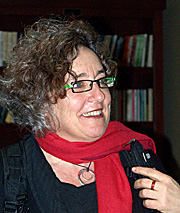By Janis Siegel, JTNews Correspondent
They were only four and five years old at the time they were hidden. While some have said they have achieved happiness now, the majority of the 70 Jewish children interviewed as adults by sociologist Diane Wolf lost a lot in Holland after the Holocaust, and they knew it.
Out of the 4,000 to 6,000 Dutch children who survived the war by being hidden with Christian families, most were returned to a surviving family member or a Jewish organization.
But for many of the 300 or so who lived with Christian families and never knew of their original Jewish identities, life is now characterized by confusion, sadness, and guilt.
In her research, Wolf talked to these survivors, who are now elderly, and found that each one had a different experience depending on the family or the orphanage they were placed in and how many times they were moved around.
“Hidden children were different than camp survivors,” Wolf told an afternoon audience at the University of Washington in February. The University of California professor of Sociology and director of the Jewish Studies Program at UC Davis presented her research findings to a group of nearly 50 at a free event sponsored by the Jewish Studies Program in the Henry M. Jackson School of International Studies at the University of Washington.
“In the camps, the children were facing death at any time,” Wolf said. “But these children had a fairly normal life and were integrated. Their trauma began after the liberation in 1945.”
Wolf’s study, described in her book, Beyond Anne Frank: Hidden Children and Postwar Families in Holland (UC Press, 2007) reveals that child survivors in the Netherlands after WWII often rejected their surviving Jewish parent who came to claim them, choosing to stay safe and comfortable in their surrogate Christian homes.
“As adults they had access to their files and found out that their [Jewish] families wanted them or their hiding families wanted them. It was really sad,” Wolf said. “Those who were sent to orphanages never got educations and eventually worked in lower earning jobs. Some went to Israel. Some of them have good family lives and some of them are unable to connect.”
Between 25,000 and 30,000 Dutch Jews survived the Holocaust in Holland, but they suffered disproportionately in their home country compared to other countries in Europe.
According to Wolf’s research, 70 percent of Holland’s 140,000 Jews were murdered, compared to the next highest murder rate in Poland, where 90 percent of the 3.3 million Jews who lived there were killed.
Figures from the Jewish Center for Public Affairs show that “the percentage of Jews from The Netherlands murdered by the Germans and their associates in World War II was higher than in any other Western European country.”
Wolf discussed the apparent myth that has persevered for many decades in the Netherlands: That the majority of the Dutch population went to great lengths to help their Jewish friends and neighbors. The last page of Anne Frank’s diary, she said, revealed the truth.
“The Dutch betrayed the Franks,” Wolf said. “Austrians hid her.”
The Christian families that hid Jews, Wolf said, were mainly young, childless, non-Jewish egalitarian Dutch couples that envisioned “a world without differences.” They saw it as a positive and helpful act to take in these Jewish children.
Those with children gave their other kids one of several explanations for the new sibling living with them, including, they were “my cousin’s daughter,” or “another family’s orphan,” or “their family got bombed,” Wolf said.
It is still not entirely clear whether these “adoptive” Dutch families’ motives were always altruistic, according to Wolf.
One survivor told Wolf that when they had turned 18, and wanted to marry another Jew, their adoptive family said, “‘We didn’t save you for that, so you could be Jewish again,’” Wolf said.
“I don’t think the Dutch have done their memory work the way the Germans have,” Wolf said. “Their national narrative became, ‘We are the resisters,’ which they weren’t. In many ways, they still feel like victims.”
Wolf believes that knowing about their past has given these would-be orphans a “new political identity.” Many have told her, “‘I’m not crazy and I’m not alone,’” she said.
According to the European Jewish Congress, hundreds of these survivors are living in Holland today and can be identified through state documents.
“Many of these Jewish families today are dysfunctional and shattered,” Wolf said.
The original committee that decided the fate of these hidden Jewish children was made up of 25 members who were mainly Christians and Protestants. Only four assimilated Jews were in the group, said Wolf, and Orthodox Jews and what she called “extremist” Jews were kept off the committee. Wolf said the selection “was done in a despicable way.”
Figures from the U.S. Holocaust Museum show that “in hundreds of cases, rescuers refused to release hidden children to their families or Jewish organizations. Some demanded that the child be ‘redeemed’ through financial remuneration. Others had grown attached to their charges and did not want to give them up. In the more difficult cases, courts had to decide to whom to award custody of the child. Some rescuers defied court decisions and hid the children for a second time.”
Wolf said the Jewish committee, at the time, was unhappy about this and established their own group to reassess the status of the surviving children. They ultimately felt that if they were doing well in Christian families, that they shouldn’t be moved.
Wolf agrees.
“I think it was better for them to stay in their hiding family,” said Wolf. “They did not have to experience a severe rupture.”
